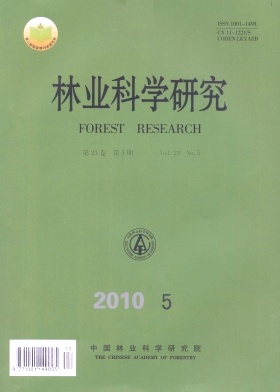Analysis on Microbial Flora in Three Types of Pinus massoniana Forests in Yunyang County of the Three Gorges Reservoir Area Ⅱ. Microflora in Woodland Air, Leaf and Bark Surface
-
1.
Research Institute of Forest Ecology, Environment and Protection, Chinese Academy of Forestry, Beijing 100091, China
-
2.
Yunyang Forestry Bureau, Chongqing City,Yunyang 404500, Chongqing, China
-
Received Date:
2008-05-24
-
Abstract
To explore the microbial flora and its seasonal variation on different types of Pinus massoniana stand, the cultivable bacteria and fungi in the forest air and on the leaf and bark surface of near-matured forest, middle-aged forest and plantation in Yunyang County of the Three Gorges Reservoir Area were analyzed. The results showed that in the aboveground of the three types of pine forest,the microorganisms were consistent with the seasons, the quantities of microorganism in summer and autumn were higher than in winter and spring, the quantities of microorganism in middle-aged natural forest were the largest and the seasonal change was also the largest; the quantity and species of dominant population varied with the seasons and forest types. The fungal species in the air of plantation were 4,3,4,3 respectively in autumn, winter, spring and summer season, while, in near-matured forest and middle-aged forest, the fungal species were 3. The dominant species diversity in plantation was higher than that in near-matured forest and middle-aged forest. The bacterial dominant species on leaf surface in near-matured forest and middle-aged forest were Pseudomonas veronii and Serratia marcescens and in plantation was Enterobacter sp. The fungi species of dominant population on the leaf surface in the middle-aged natural forest and plantation were the same in four seasons, which including Aspergillus versicolor, Pestalotiopsis neglecta and Aspergillus nomius. However, they were Aspergillus versicolor, Pestalotiopsis neglecta and Aspergillus sydowii in the near-matured forest. The dominant bacteria population on the bark surface in near-matured forest was Pseudomonas sp., which took the highest percentage in the dominant species among the three types of forest lands and were 69.05%, 65.58%, 57.08% and 80.57% respectively in autumn, winter, spring and summer. The dominant bacteria species in the middle-aged natural forest was Bacillus subtilis and in plantation was Neisseria sp. The dominant fungi species on the bark surface in near-matured forest were Penicillium waksmanii and Pestalotiopsis neglecta, and in plantation were Penicillium spp. and Aspergillus spp., but in middle-aged forest, there was only one species of Mucorales, its quantity percentage in autumn, winter, spring and summer were 63.38%, 65.76%, 51.23% and 84%, respectively, which was significantly higher than those in the other two types of forest.
-

-
References
|
[1]
|
程东升.森林微生物生态学[M].哈尔滨:东北林业大学出版社,1993:300-329
|
|
[2]
|
金 静,王远路,刘建平,等. 三种杨树树皮真菌群落的研究[J].林业科学研究, 2004,17(4):490 - 49
|
|
[3]
|
徐美琴,陈 萍,李 玉,等. 湿室培养针叶树皮生黏菌的初步研究[J].菌物研究,2006,4(1):14-19
|
|
[4]
|
郭文硕,陈文相.叶围微生物研究综述[J].福建林业科技,2003(3):47-52
|
|
[5]
|
徐梅卿,何平勋.中国木本植物病原总汇[M].哈尔滨:东北林业大学出版社,2008
|
|
[6]
|
姜广正,郑是琳,李荣禧,等. 中国叶围煤污菌初探[J].微生物学报,1990,30(3):201-209
|
|
[7]
|
潘学仁,黄永清,刘传照.枫桦红松林凋落物分解真菌生态群的研究[J].东北林业大学学报, 1991(1):75-82
|
|
[8]
|
黄永清,邵力平,马俊莹.树栖真菌群落多样性研究——红松芽、叶及短枝栖真菌群落组成分析[J].菌物系统, 1997,16(3):182-188
|
|
[9]
|
牟新涛,李 永,李强军,等. 三峡库区云阳县三种类型马尾松林微生物区系分析 I. 林地土壤细菌、芽孢杆菌和真菌[J]. 林业科学研究,2010,23(4):560-566
|
|
[10]
|
张玉玲,黄 琼,汪安云,等.白肋烟晾制期间烟叶中细菌的分离和鉴定[J].中国烟草学报,2007, 13(1):37-40
|
|
[11]
|
罗 兰,袁忠林,陈 茎.小麦全蚀病菌拮抗细菌的筛选及鉴定[J].莱阳农学院学报, 2006,23(3):205-207
|
|
[12]
|
东秀珠, 蔡妙英. 常用细菌系统鉴定手册[M].北京:科学出版社,2001:353-398
|
|
[13]
|
布坎南 R E,吉本斯 N E. 伯杰细菌鉴定手册 [M].第八版.北京:科学出版社,1984
|
|
[14]
|
魏景超. 真菌鉴定手册[M].上海:上海科学技术出版社,1979
|
|
[15]
|
Gardes M, Bruns T D. ITS primer with enhanced specificity for basidiomycetes: Application to the identification of mycorrhizae and rusts[J].Mol Ecol,1993:113-118 |
|
[16]
|
张志华,洪 葵.核酸序列直接分析在真菌鉴定方面的应用[J].华南热带农业大学学报,2006,12(2):39-42
|
|
[17]
|
刘春来,文景芝, 杨明秀,等. rDNA-ITS 在植物病原真菌分子检测中的应用[J].东北农业大学学报,2007,38(1):101-106
|
|
[18]
|
李春义,马履一,徐 昕.抚育间伐对森林生物多样性影响研究进展[J].世界林业研究,2006,19(6):27-31
|
|
[19]
|
焦如珍,杨承栋,屠星南,等.杉木人工林不同发育阶段林下植被、土壤微生物、酶活性及养分的变化[J].林业科学研究, 1997, 10(4):373-379
|
|
[20]
|
盛炜彤,杨承栋,范少辉. 杉木人工林的土壤性质变化[J].林业科学研究,2003,16 (4):377-385
|
-
-
Proportional views

-





 DownLoad:
DownLoad: